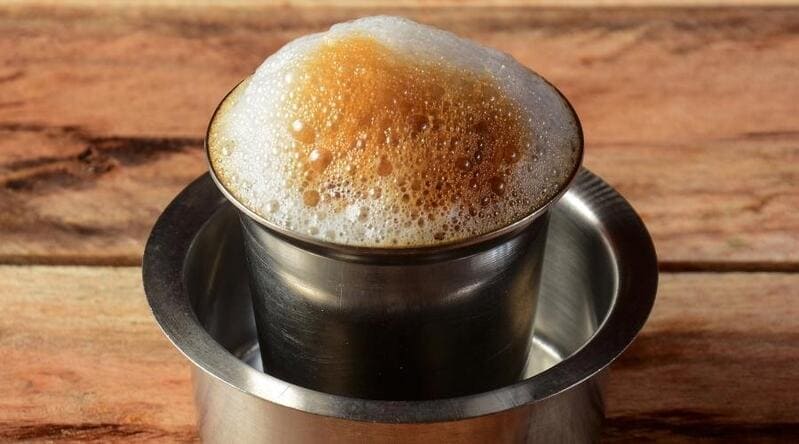
Both the Indian coffee filter and French press are popular devices for brewing coffee manually, but they are slightly different in how they operate.
Indian Coffee Filter vs French Press:
The main difference between a French press and an Indian coffee filter is that a French press uses immersion brewing while an Indian coffee filter uses drip (pour-over) brewing.
Immersion brewing is done with a coarse grind. The coffee grounds are immersed in water and then blended together.
Drip brewing can be done with a medium, medium-fine, and medium-coarse grind. It also involves adding water gradually over your coffee grounds.
Indian Coffee Filter vs French Press Caffeine And Flavors
Another difference between a French press and an Indian coffee filter is the quality of caffeine produced. The French press works well with coarse to medium-coarse grounds, and does not filter out any flavors.
The Indian coffee filter, on the other hand, uses finely ground coffee that may reduce the flavors in it. Generally, the Indian coffee filter is an excellent choice if you want less oil in your coffee, as the dripping/filtration process tends to separate the mineral oils.
Chicory is incorporated into the coffee beans to add a sophisticated, bittersweet flavor. This flowering plant belongs to the dandelion family, and it is quite tough.
Its roots are ground up and brewed with the coffee to create the unique flavor. Sugar and boiled whole milk are then added to even out the bitter taste.
Indian Coffee Filter?

The Indian coffee filter is a small, cylindrical, traditional coffee brewing device that can be traced back to Southern India.
An Indian coffee filter has four parts:
- A lid to cover the device
- A small tamper
- Tiny filtering holes
- A top compartment
- A bottom container for holding the brewed coffee
What Is So Unique About Indian Filter Coffee?
Despite being one of the most consumed beverages today, coffee is not native to India, let alone South India. In fact, no one knows for sure how it made its way into the country.
Some say it was smuggled from Yemen by a Sufi pilgrim in the sixteenth century. Others believe it was introduced by the French.
Whatever the case, it’s safe to say that coffee drinking did not have a great start in South India.
Back then, coffee was considered an upper class Brahmanical beverage, which led directly to the Tamil castle’s fight for the right to access coffee houses in the early 1900s, and the subsequent formation of the Coffee Board of India in the 1940s to promote the production of coffee.
By this time, South India had already begun growing enough Robusta and Arabica beans not only for export, but also for domestic consumption.
These high quality beans are no doubt instrumental in distinguishing South Indian filter coffee, but they are not the only thing that makes it stand out. It is also about how those beans are ground and roasted, brewed, and finally served. Families often pass these rituals down to their kin.
The addition of chicory also plays a major role in separating Indian filter coffee from the rest. South Indian coffee lovers are divided when it comes to the usage of chicory. Purists hate its presence in their coffee drinks, while others find its distinctive aroma and bitter flavor to be rather refreshing.
The tradition of adding chicory in Indian filter coffee started during World War 2, when the industry suffered a major setback due to the disruption of coffee trade routes. Coffee was substituted with chicory when there was a shortage.
When you add hot milk and sugar, the chicory-coffee essence tastes a lot like filter coffee.
When shopping for your Indian filter coffee recipe, always check if the brand is pure or contains added chicory. You should also keep in mind that different brands have different levels of chicory. Too much chicory, when combined with sugar and milk, may be a problem for some people.
The other feature that makes South Indian filter coffee so unique is the filter equipment itself.
The apparatus is simple but effective. It is a brass or stainless steel percolator split into two, with an airtight lid and a plunger. Tiny holes are pierced on the bottom of the upper chamber, through which the filtered coffee collects into the cylinder below.
Filter coffee is deeply ingrained in South Indian food culture, and it is easy to see how choosing between Indian coffee filter vs French press can be challenging. Generally, the French press is a good choice if you want to have your coffee as fast as possible.
On the other hand, the Indian coffee filter is more desirable if you are watching your weight, as it filters out oils from coffee grounds that may produce bad cholesterol in your body.
Brewing Process With an Indian Coffee Filter
When using an Indian coffee filter, you basically pour water over your grounds, through a coffee filter, as the name suggests.
An Indian coffee filter has two cylinders that are attached together. You drop one or two scoops of finely ground coffee (depending on how much caffeine you need) into the top compartment.
The grounds should be powdery, almost like espresso, to create a more condensed drink.
Place a lightweight “tamper” right over your coffee grounds to contain them. Your Indian coffee filter will likely come with the temper, so you don’t have to worry about getting one.
Next, you gently and gradually add water into the upper compartment, a little at a time. This process can take up to 20 minutes, depending on the amount of coffee you are brewing.
This is because the filter holes are extremely small, so it takes a long while for the water to penetrate the grounds and get through.
If there’s room, you can add all the water at once then cover with a lid and wait. You could even do this in the evening in a large batch and leave it overnight.
The bottom container collects the liquid coming through the filter holes. This liquid should be thick, but without a crema like in espresso. Some coffee filters can produce up to five cups of coffee.
At this point, the coffee is referred to as “decoction.”
Traditionally, after brewing your coffee, you are supposed to pour it back and forth between a tumbler and a dabarah to cool it. A dabarah is a small metallic cup that does not get too hot.

You can also use this process to mix in some hot milk and sugar, as well as aerate the drink.
Sometimes this coffee is called “meter coffee” because of the back and forth pouring between the tumbler and dabarah. Other popular names for the drink include: kaapi, Madras kaapi, Mylapore filter coffee, and Kumbakonam degree coffee.
Once you have cooled the coffee to drinking temperature, you can serve it in your dabarah, which is usually placed in the tumbler.
French Press Explained

The French Press is a popular manual device commonly used to make coffee at home. The device was invented by an Italian designer in 1929. Since then, the gadget has gone through several changes designed to improve its efficiency.
A modern French press consists of a container (stainless steel or glass) with handle, a cylindrical mesh (stainless steel) just below the top, and a cover (steel) with a movable plunger. If you have never seen it before, you might mistake it for a creamer or teapot.
The French press goes by many names: coffee press, coffee plunger, etc.
Whatever you call it, this classic coffee maker is undoubtedly popular among coffee lovers across the globe.
Brewing Process With A French Press
The French press is made up of two main parts:
1. The filter, plunger, and lid
French presses are built with a metal filter that does not block out fine particles and natural oils from your coffee grounds. As a result, French press coffee has a conspicuously rich and thick texture.
The metal filter is linked to a metal rod passing through the top. This rod is called the plunger and its work is to press the coffee grounds down the coffee maker during the brewing process.
The filter is sized to perfection, with sufficient pressure on the sides to keep coffee particles from penetrating when you press the plunger.
2. The handle, base, and beaker
Most beakers are made of glass, and others use ceramic, metal, or plastic. The purpose of the beaker is to collect the water and coffee steeping through the filter, so that you can then serve it into your cup.
When brewing with a French press, you typically start by preparing your coffee grounds and heating your water.
Then combine the coffee grounds and water in the French press cylinder and press the plunger gently to push the coffee grounds into the water.
Wait 3 to 4 minutes then press the plunger all the way down.
This method is ideal when using coarse to medium-coarse grounds. If you use finely ground coffee, the resultant drink may have a bitter or overly harsh taste.
Apart from the French press, other devices that use immersion brewing include the Café Solo, the Aeropress, and the Clever immersion brewer.
With immersion brewing, you can control:
- The size of your grounds
- The water temperature
- How long the water and coffee grounds interact
Once you are done brewing, you simply pour the liquid through a filter and enjoy your immersion-brewed coffee.
Most people like the French press because it does not require fancy equipment such as a supply of filter papers, a long neck kettle, or even electricity. The minimum requirements for brewing French press coffee are a French Press, ground coffee, and hot water.
Some people prefer acquiring an electric kettle for easier french press brewing, but that’s totally optional.
Final Thoughts:
There is a certain sense of nostalgia that comes with using manual brewing apparatus.
Unlike coffee machines that rely on technology to automatically set the temperature and brew time, manual devices allow you to experiment with your drink, refining every aspect until you find the perfect formula for your taste.
When it comes to proper manual brewing equipment, two names with unique applications stand out. the French press and the Indian coffee filter.
I hope this article helped you explore the Indian coffee filter and see how it compares in functionality to the renowned French press.
